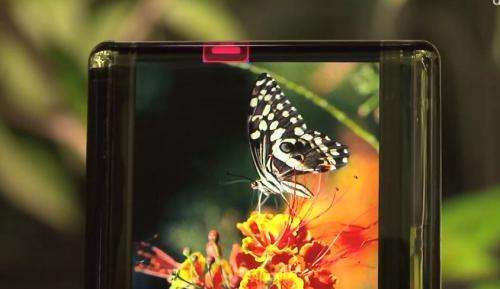(Phys.org) —On hand at the recent FPD 2013 show in Japan, a key event focused on the flat panel display industry, an impressive show of prototypes from Semiconductor Energy Laboratory (SEL) showed what is possible in achieving color and clarity in flexible OLED displays and panels. Yoshitako Yamamoto of SEL demonstrated "concept" display and non-display devices using its c-axis aligned crystal (CAAC) technology. The report on the demo from DigInfo News clearly indicates SEL's research edge through use of CAAC oxide semiconductors. CAAC is described as a novel crystalline structure without clear grain boundaries.
Yamamoto discussed advantages of using CAAC for flexible displays in that they can be freely designed.
Another feature of CAAC is that it does not break easily, because the crystals are continuously aligned, he said. "So, it isn't damaged much even if it's bent. A display that can be bent into a diameter of 4 mm is probably unparalleled worldwide. In particular, this is the only technology that can display a picture on bent edges."
He said the high resolution, which was evident in the video demo of the prototypes, can even be achieved in big displays. SEL's large flexible display prototype is claimed to be the world's largest OLED display with a plastic substrate, at 13.5 inches. A high-definition display has 4K resolution at 326 ppi. The flexible material enables a lightweight, bendable display, less than 100 microns thick and weighing just 10 g.
Included in the demo were side-roll and top-roll OLED displays, with the display curving over the edge.
Working on semiconductor materials, the company, founded in 1980, has a model that is focused on research and development and patenting rather than manufacturing and sales.
"In this material's structure," said Yamamoto, "the crystals are aligned in the c-axis direction. Because CAAC itself is crystalline instead of amorphous, it has much higher reliability. Until now, with oxide semiconductors, reliability was generally thought to be a problem, but using this material solves that problem," he said. In addition to its use for bendable displays, SEL can adapt the technology to fashion bendable batteries. Obviously, bendable batteries support a promising commercial potential in wearables.
The SEL prototype wrist device had a 3.4-inch OLED display and a bendable lithium ion battery. Qi wireless charging and Bluetooth were noted in the report. In tests, where the battery was repeatedly bent with the curvature expected in a wrist device, it could be put on and taken off over 10,000 times.
More information: www.sel.co.jp/en/02_RandD/os.html
via Diginfo
© 2013 Phys.org
























